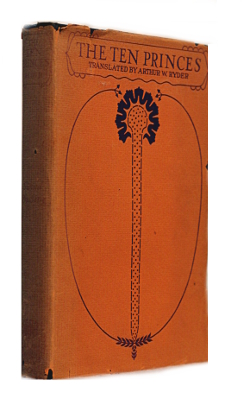About the book (from Wikipedia):
Dashakumaracharita (The narrative of ten young men, IAST: Daśa-kumāra-carita, Devanagari: दशकुमारचरित) is a prose romance in Sanskrit, attributed to Dandin (दण्डी) in the 7th century CE, though there is some obscurity surrounding its textual tradition, the identity of the author and the date of composition.
It describes the adventures of ten young men, the Kumaras, all of whom are either princes or sons of royal ministers, as narrated by the men themselves (however, there are irregularities in the text). These narratives are replete with accounts of demigods, ghosts, prostitutes, gamblers, intrigues with voluptuous women, astonishing coincidences, cockfights, anthropophagy, sorcery, robberies, murders and wars. The reader is treated to some very striking passages; for instance, a seductive young girl (all of whose anatomical features are very frankly described) deftly prepares a fragrant meal of rice-gruel and vegetables for her prospective suitor in the sixth chapter of the Dashakumaracharita.
About Dandin (from Wikipedia):
Daṇḍin is a 6th-7th century Sanskrit author of prose romances and expounder on poetics. Although he produced literature on his own, most notably the Daśakumāracarita, first translated in 1927 as Hindoo Tales, or The Adventures of the Ten Princes, he is best known for composing the Kāvyādarśa (‘Mirror of Poetry’), the handbook of classical Sanskrit poetics, or Kāvya. His writings were all in Sanskrit. He lived in Kanchipuram in modern-day Tamil Nadu.


